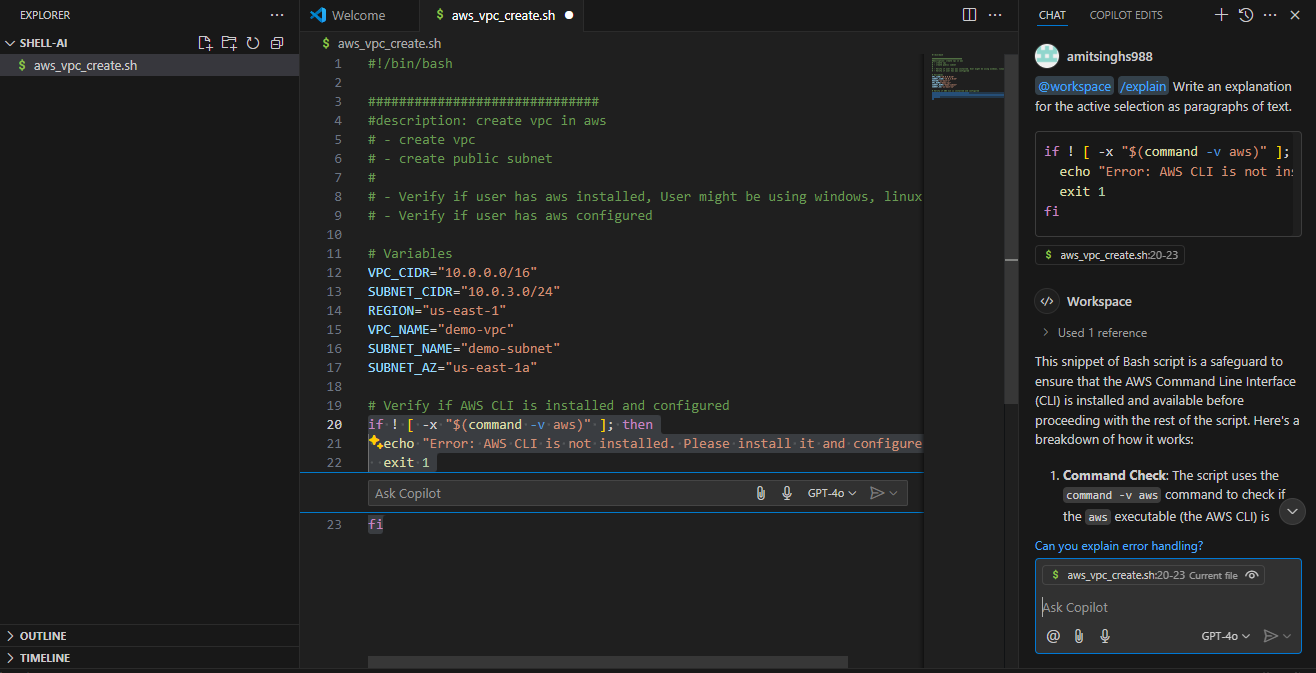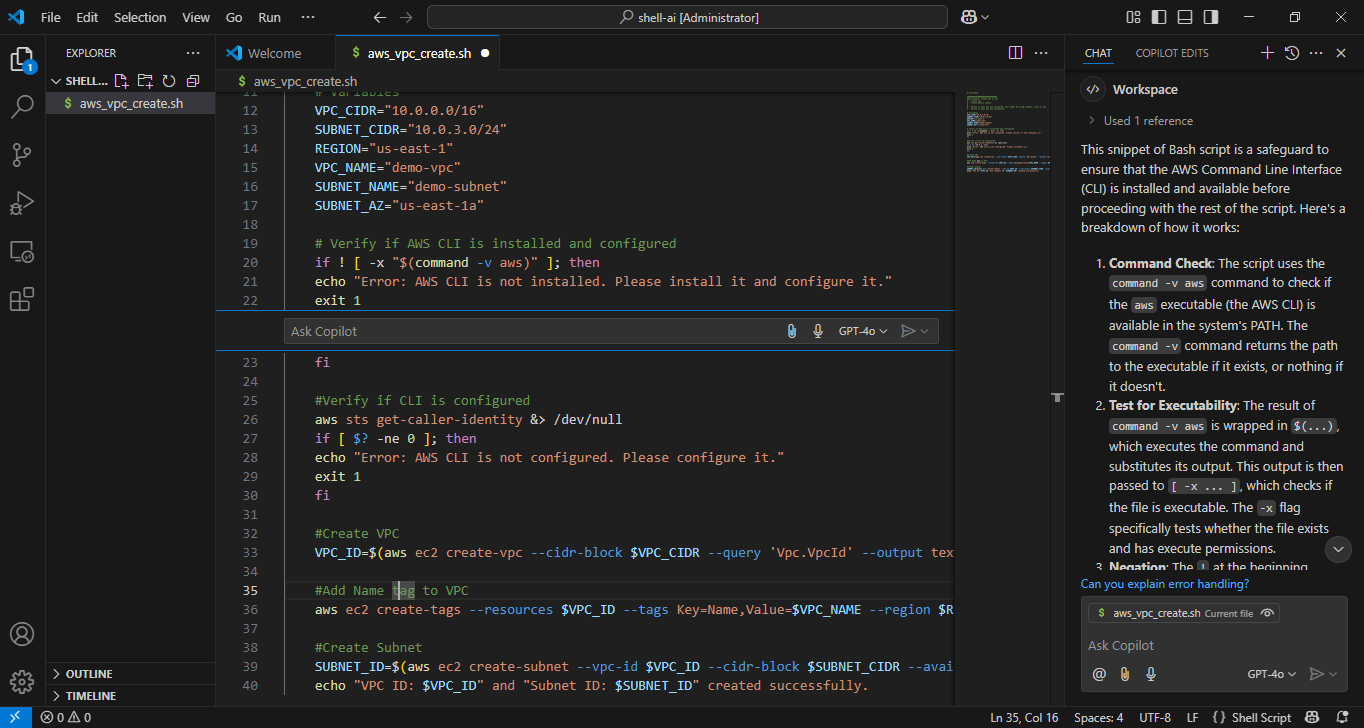AI-Assisted Shell Scripting – GenAI For DevOps
 Amit singh deora
Amit singh deoraAI-assisted shell scripting. You might be wondering, why is this the easiest? read the blog and you’ll understand why AI-powered shell scripting is a game changer.
What Is AI-Assisted Shell Scripting?
Simply put, AI-assisted shell scripting means using AI tools—such as chatbots or AI-powered coding assistants—to write efficient shell scripts.
"which DevOps task benefits the most from AI?"
Without a doubt, it is shell scripting.
Why Does AI Work So Well for Shell Scripting?
Let’s compare it with other scripting languages.
Python and AI: The Challenges
When you generate Python code using AI, it often:
Uses outdated modules or deprecated packages
Includes libraries that may have security vulnerabilities (CVEs)
Requires additional security scanning to ensure safety
Needs frequent updates to match new versions of dependencies
This can lead to inefficiencies and wasted time debugging AI-generated code.
Terraform and AI: The Limitations
Terraform relies on provider versions that frequently change.
Modules may update their parameters, breaking older scripts.
Kubernetes and AI: The Inconsistencies
API versions in Kubernetes are regularly updated.
Certain fields and configurations become obsolete over time.
Now, here’s the good news: Shell scripting does not suffer from these issues!
The Stability of Shell Scripting
Shell scripting is essentially a set of shell commands combined into a script.
The core Linux commands—like cd, ls, pwd, grep, awk, and for loops—rarely change over time.
For example:
A
grepcommand written 11 years ago will still work today.Even if command parameters change, they remain backward compatible.
This is why AI-generated shell scripts work reliably—without the need for frequent updates.
AI-Powered Pair Programming
Now, let’s move to the exciting part: AI Pair Programming.
What Is AI Pair Programming?
Think of how a junior engineer learns from a senior developer:
The senior dev reviews their code.
They offer suggestions and best practices.
They guide them through complex logic.
Now, replace the senior developer with AI—that’s AI pair programming!
AI tools like GitHub Copilot can:
Observe your code as you write.
Suggest improvements in real-time.
Auto-complete repetitive tasks to save time.
Getting Started with AI-Powered Shell Scripting
Install GitHub Copilot
Open Visual Studio Code (VS Code).
Go to the Extensions tab.
Search for GitHub Copilot.
Click Install.
Now, GitHub Copilot will assist you in writing shell scripts. If you ever want to disable it, just click the Disable button.
Creating an AI-Assisted Shell Script
Let’s create a shell script to deploy an AWS VPC and a public subnet using AI assistance.
Step 1: Set Up Your Script File
Open your terminal.
Create a new folder:
mkdir Shell_Example && cd Shell_ExampleOpen VS Code and create a new script file:
touch AWS_VPC_create.sh
💡 Best Practice: Use meaningful filenames to give AI proper context.

Step 2: Add a Description
At the start of the script, add comments explaining:
What the script does (e.g., creates a VPC and a subnet).
Any required conditions (e.g., AWS CLI must be installed and configured).
#!/bin/bash
# Description: Create an AWS VPC with a public subnet
# Prerequisites:
# 1. AWS CLI must be installed
# 2. AWS CLI must be configured with access keys
💡 Tip: AI uses these descriptions to understand what you're trying to achieve.
Step 3: Let AI Generate the Script
Now, GitHub Copilot will start suggesting code. You just need to press "Tab" to accept suggestions!
#!/bin/bash
##############################
#description: create vpc in aws
# - create vpc
# - create public subnet
#
# - Verify if user has aws installed, User might be using windows, linux or mac.
# - Verify if user has aws configured
# Variables
VPC_CIDR="10.0.0.0/16"
SUBNET_CIDR="10.0.3.0/24"
REGION="us-east-1"
VPC_NAME="demo-vpc"
SUBNET_NAME="demo-subnet"
SUBNET_AZ="us-east-1a"
# Verify if AWS CLI is installed and configured
if ! [ -x "$(command -v aws)" ]; then
echo "Error: AWS CLI is not installed. Please install it and configure it."
exit 1
fi
#Verify if CLI is configured
aws sts get-caller-identity &> /dev/null
if [ $? -ne 0 ]; then
echo "Error: AWS CLI is not configured. Please configure it."
exit 1
fi
#Create VPC
VPC_ID=$(aws ec2 create-vpc --cidr-block $VPC_CIDR --query 'Vpc.VpcId' --output text --region $REGION)
#Add Name tag to VPC
aws ec2 create-tags --resources $VPC_ID --tags Key=Name,Value=$VPC_NAME --region $REGION
#Create Subnet
SUBNET_ID=$(aws ec2 create-subnet --vpc-id $VPC_ID --cidr-block $SUBNET_CIDR --availability-zone $SUBNET_AZ --query 'Subnet.SubnetId' --output text --region $REGION)
echo "VPC ID: $VPC_ID" and "Subnet ID: $SUBNET_ID" created successfully.
Done! You just created an AWS VPC and subnet without writing a single line manually!

You will keep getting suggestions by default when you will write script.
Additional AI Tools for Shell Scripting
✅ GitHub Copilot (Free Trial, Paid Plan Available)
✅ Cursor AI (Better for Python & Terraform, Free for Limited Use): free for limited tokens
✅ Pieces for Developers (Alternative to Copilot)
If you’re looking for a completely free tool, GitHub Copilot is your best choice.
Final Thoughts
AI-powered shell scripting is an absolute game-changer.
Unlike Python, Terraform, or Kubernetes, shell scripts stay relevant for years.
AI tools can save time, improve efficiency, and enhance coding best practices.
Subscribe to my newsletter
Read articles from Amit singh deora directly inside your inbox. Subscribe to the newsletter, and don't miss out.
Written by

Amit singh deora
Amit singh deora
DevOps | Cloud Practitioner | AWS | GIT | Kubernetes | Terraform | ArgoCD | Gitlab